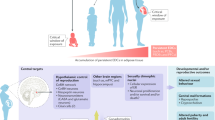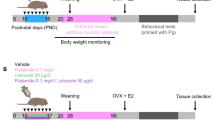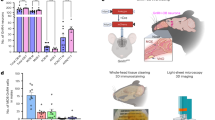Abstract
GROUPING females together often suppresses oestrous cycles in mice if females are maintained in an environment free of male odour1,2. Such suppression may take the form of either an increased incidence of spontaneous pseudopregnancy or, more commonly, a general prolongation of the dioestrous phase of the cycle. This kind of induced pseudopregnancy is greatly reduced by olfactory lobectomy3,4, but the dioestrous response to grouping has not been unequivocally established as an olfactory-mediated effect. A separate body of literature, dealing largely with all male or mixed sex groups of mice, has emphasized a concept that relates the neurogenic stressors associated with high density (social stress) to increased release of adrenocorticotrophin and a concurrent depression of circulating gonadotrophin5. Specificity of sensory mediation has not been of real interest in these studies.
This is a preview of subscription content, access via your institution
Access options
Subscribe to this journal
Receive 51 print issues and online access
$199.00 per year
only $3.90 per issue
Buy this article
- Purchase on SpringerLink
- Instant access to full article PDF
Prices may be subject to local taxes which are calculated during checkout
Similar content being viewed by others
References
Whitten, W. K., J. Endocrinol., 18, 102 (1959).
Whitten, W. K., in Adv. Reprod. Physiol. (edit. by McLaren, A.), 1, 155 (Academic and Logus Press, London, 1966).
van der Lee, S., and Boot, L. M., Acta Physiol. Pharmacol. Neerl., 5, 213 (1956).
Biancifiori, C., and Caschera, F., Brit. J. Cancer, 17, 116 (1963).
Christian, J. J., Lloyd, J. A., and Davis, D. E., in Rec. Prog. Hormone Res., 14, 501 (Academic Press, London and New York, 1965).
Guillemin, R., Clayton, G. W., Lipscomb, H. S., and Smith, J. D., J. Lab. Clin. Med., 53, 830 (1959).
Parkes, A. S., and Deanesly, R., in Marshall's Physiol. Reprod. (edit. by Parkes, A. S.), 3, 1064 (Little, Brown and Co., Boston, 1966).
Marsden, H. M., and Bronson, F. H., J. Endocrinol., 32, 313 (1965).
Mikolajczyk, H., Nature, 213, 806 (1967).
Christian, J. J., Proc. Soc. Exp. Biol. Med., 104, 330 (1960).
Weltman, A. S., Sackler, A. M., Sparker, S. B., and Opert, S., Fed. Proc., 21, 184 (1962).
Mody, J. K., and Christian, J. J., J. Endocrinol., 24, 1 (1962).
Hatch, A., Wilberg, G. S., Balaza, T., and Grice, H. C., Science, 142, 507 (1963).
Chipman, R. K., and Fox, K. A., J. Reprod. Fertil., 12, 233 (1966).
Author information
Authors and Affiliations
Rights and permissions
About this article
Cite this article
BRONSON, F., CHAPMAN, V. Adrenal-oestrous Relationships in Grouped or Isolated Female Mice. Nature 218, 483–484 (1968). https://doi.org/10.1038/218483a0
Received:
Revised:
Published:
Issue date:
DOI: https://doi.org/10.1038/218483a0
This article is cited by
-
Sozialer Stress bei Tupajas (Tupaia belangeri)
Zeitschrift f�r Vergleichende Physiologie (1969)



